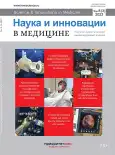Human levator ani muscular tissue ultrastructural organization
- Authors: Chemidronov S.N.1, Kolsanov A.V.1, Suvorova G.N.1
-
Affiliations:
- Samara State Medical University
- Issue: Vol 8, No 3 (2023)
- Pages: 165-168
- Section: Human Anatomy
- URL: https://journal-vniispk.ru/2500-1388/article/view/249944
- DOI: https://doi.org/10.35693/2500-1388-2023-8-3-165-168
- ID: 249944
Cite item
Full Text
Abstract
Aim – an electron microscopic study of the muscle tissue of levator ani muscle in human.
Material and methods. The paper describes the muscle tissue of levator ani muscle. The data was obtained by light-optical and electron microscopic examination of muscle tissue.
Results. The study of the ultrastructural organization of the muscle tissue of levator ani muscle in human shows that it corresponds to the structure of skeletal muscle tissue – it consists of muscle fibers that are cellular-symplastic structures. The main volume of the myosimplast is occupied by myofibrils located along its longitudinal axis, having a distinct sarcomeric organization – sarcomeres are separated by Z-lines, a dark disс is located on both sides of the centrally located M-line, light disсs are located on both sides of the Z-lines.
Conclusion. Levator ani muscle in human belongs to the striated skeletal muscle tissue of the locomotor type.
Full Text
##article.viewOnOriginalSite##About the authors
Sergei N. Chemidronov
Samara State Medical University
Author for correspondence.
Email: s.n.chemidronov@samsmu.ru
ORCID iD: 0000-0002-9843-1065
PhD, Associate professor, the Head of the Department of Human Anatomy
Russian Federation, SamaraAleksandr V. Kolsanov
Samara State Medical University
Email: a.v.kolsanov@samsmu.ru
ORCID iD: 0000-0002-4144-7090
PhD, Professor of RAS, the Head of the Department of Operative Surgery and Clinical Anatomy with a course of innovative technologies
Russian Federation, SamaraGalina N. Suvorova
Samara State Medical University
Email: g.n.suvorova@samsmu.ru
ORCID iD: 0000-0002-0462-1344
PhD, Professor, the Head of the Department of Histology and Embriology
Russian Federation, SamaraReferences
- Korik VE, Kluyko DA, But-Husaim GV, Bogdan VG. Abdominal compartment syndrome: a state-of-the-art review of diagnostic and treatment. Voennaya meditsina. 2016;3:127-133. (In Russ.). [Корик В.Е., Клюйко Д.А., Бут-Гусаим Г.В., Богдан В.Г. Абдоминальный компартмент-синдром: современные аспекты диагностики и лечения. Военная медицина. 2016;3:127-133].
- Esin RG, Fedorenko AI, Gorobets EA. Chronic nonspecific pelvic pain in women: a multidisciplinary problem (review). Medical almanac. 2017;5(50):97-99. (In Russ.). [Есин Р.Г., Федоренко А.И., Горобец Е.А. Хроническая неспецифическая тазовая боль у женщин: мультидисциплинарная проблема (обзор). Медицинский альманах. 2017;5(50):97-99].
- Miklos JR, O’Reilly MJ, Saye WB. Sciatic hernia as a cause of chronic pelvic pain in women. Obstetrics and Gynecology. 1998;91(6):998-1001. doi: 10.1016/s0029-7844(98)00085-4
- Gorelik SG, Kolesnikov SA, Myasnikov AD. Surgical access to pelvic floor hernias. Patent RU 2 269 302 C2, published. 02.10.2006. (In Russ.). [Горелик С.Г., Колесников С.А., Мясников А.Д. Операционный доступ к грыжам тазового дна. Патент RU 2 269 302 C2, опубл. 02.10.2006].
- Nyangoh Timoh K, Deffon J, Moszkowicz D, et al. Smooth muscle of the male pelvic floor: an anatomic study. Clinical Anatomy. 2020;33(6):810-822. doi: 10.1002/ca.23515.hal-02397615
Supplementary files










